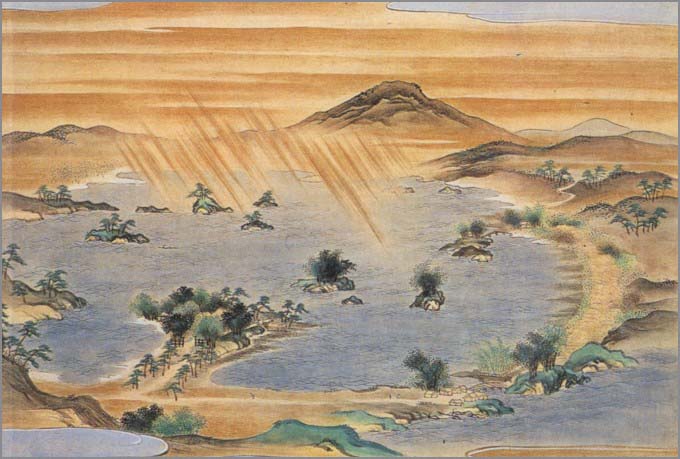The cherry blossoms are here. Not only do they make all people happy when we see them, but might they also cheer up nature itself? Issa had some thoughts.
象潟もけふは恨まず花の春
kisagata mo kyō wa uramazu hana no haru[1]
even kisakata
isn’t as sorrowful today
spring blossoms
—Issa[2]

Kisakata, or Kisa lagoon, was a famous place in Akita back in the day. It was considered one of the most beautiful places in the country, in fact, known for the 99 islands. It was a beautiful lagoon with many small islands within. Poets and other travels had been visiting this area for generations to see the majesty of it.
Unfortunately in 1804 there was a major earthquake that raised the seabed two meters, which gradually in the years after destroyed the lagoon. Today the islands all remain but they are surrounded by rice fields instead of water, which as you might imagine, somewhat ruins the old effect. It is still a popular place to visit, especially in spring when the flooded rice fields give a hint of what it used to look like.
This haiku was written in 1789, however, several years before that event. Issa isn’t calling Kisakata sorrowful because of the earthquake that hadn’t even happened yet, instead he is referring back to Bashō. Bashō visited the area exactly one hundred years before, in 1689, and later wrote about it in his famous Oku no Hosomichi. In the prose surrounding his haiku, he wrote that Kisakata is as beautiful as Matsushima, which is a place similar to Kisakata but on the Pacific side of Japan, but while Matsushima is happy, Kisakata is sad, with a feeling of melancholy.
松嶋は笑ふが如く、象潟はうらむがごとし。寂しさに悲しみをくはえて、地勢魂をなやますに似たり。
Matsushima appears joyous, as though it laughs, while Kisakata seems to bear a grudge, as if resentful. The solitude intensifies the sadness, as if the very spirit of the land itself is troubled.[3]
“The solitude intensifies the sadness”. This is playing into the stereotype of the Sea of Japan side of Japan. Historically, the Japan Sea side of Japan is consider to have more of a somber, isolated, sad feeling. There are many reasons for this: the rugged coastline, the harsher weather in winter, the historic remoteness. Sado island, located on this side, just off the coast of Niigata, was historically a place of exile. Most influential in this sorrowful feeling may have been the downfall of the Heike, and the death of young Emperor Antoku.[4] This story casts a feeling of loss that influenced all literature and poetry that followed. These things undoubtedly influenced Bashō in his idea that Kisakata was a sad and lonely place.
So here comes Issa. Ever the happy and playful personality, Issa is poking at Bashō’s a little, saying that even sad Kisakata (we might imagine a slightly sarcastic wink of the eye when he says that) is not quite as sad in the spring when the cherry blossoms come out. As we have seen in the past, Issa was always trying to use humor and playfulness in his haiku, a key factor to his popularity over the years.
I translated it as “spring” blossoms above, but in haiku any mention of blossoms always means cherry blossoms.
-
I haven’t written much about poor Emperor Antoku or the Heike Monogatari, but you can get a few hints of this history by reading The Story of Hoichi the Earless. ↩